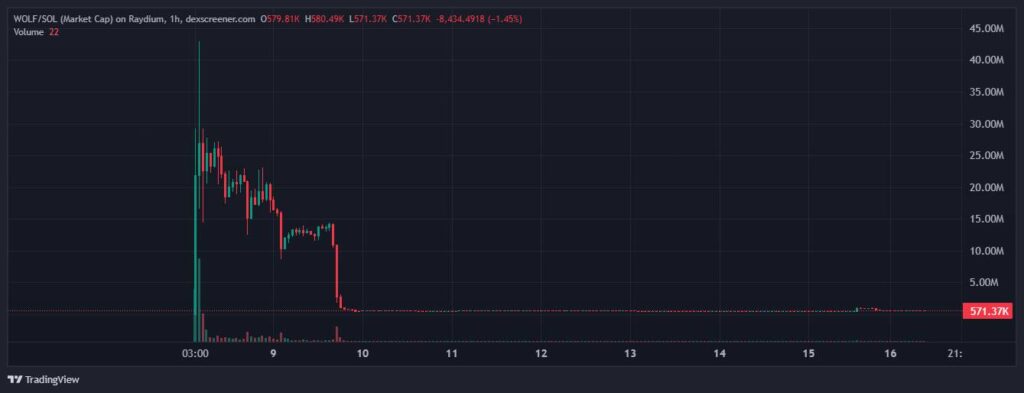In a gripping twist within the cryptocurrency landscape, a so-called crypto whale has reportedly manipulated the price of a memecoin known as Jelly my Jelly (JELLY) on the decentralized exchange Hyperliquid. The unidentified trader’s actions have left a significant footprint on the market, yielding an impressive profit of .26 million by exploiting Hyperliquid’s liquidation parameters. Blockchain analysts are tracking this intriguing saga, revealing that the whale still possesses nearly million worth of the JELLY token.
According to a detailed report by blockchain intelligence firm Arkham, the whale executed a series of large trading positions in a rapid five-minute window, including two long positions totaling over million and a short position of .1 million intended to offset the initial trades.
The price of JELLY soared by an astounding 400%, yet the whale’s substantial short position was not immediately liquidated, an unusual occurrence attributed to its sheer size. Instead, it was absorbed into Hyperliquid’s liquidity mechanisms. Investigative analyst ZachXBT noted that five addresses connected to this entity still control about 10% of the JELLY supply, having acquired all the tokens since March 22, 2025.
“Five addresses linked to the entity who manipulated JELLY on Hyperliquid still hold ~10% of the JELLY supply on Solana (.9M+),” ZachXBT reported via Telegram.
This incident is particularly troubling as the whale continues to sell tokens even after Hyperliquid took the steps to freeze and delist JELLY due to “evidence of suspicious market activity.” The fallout from JELLY’s collapse is part of a broader pattern of memecoin scandals, with previous tokens like WOLF/SOL witnessing drastic declines shortly after launch.
Alvin Kan, chief operating officer at Bitget Wallet, reflected on the situation, stating, “The JELLY incident is a clear reminder that hype without fundamentals doesn’t last,” emphasizing the fleeting nature of trends built on speculation rather than utility.
The Hyper Foundation, responsible for Hyperliquid’s ecosystem, has indicated that it will provide automatic reimbursements to most affected users, raising complex questions about decentralization and control in the rapidly evolving DeFi space. As scandals proliferate, it appears the memecoin market faces increasing scrutiny, underscoring the need for robust frameworks that protect investors while fostering innovation.
Key Points on the JELLY Memecoin Incident
The recent incident involving the JELLY memecoin highlights critical issues in the cryptocurrency market, particularly regarding speculation, manipulation, and the implications for investors.
- Whale Manipulation:
An unidentified crypto whale allegedly manipulated the price of the JELLY token, resulting in significant profit and raising ethical concerns about market fairness.
- Financial Gains:
The manipulator made approximately .26 million by exploiting trading parameters on the Hyperliquid decentralized exchange.
- Current Holdings:
The whale currently retains nearly million worth of JELLY tokens, holding about 10% of the total supply, which raises questions about their future market influence.
- Market Response:
Despite being frozen and delisted due to suspicious activity, the whale continues to sell JELLY tokens, illustrating ongoing market risks for investors.
- Lack of Fundamentals:
The incident underscores the notion that cryptocurrencies driven by hype rather than solid fundamentals are vulnerable to drastic fluctuations.
- Decentralization Concerns:
Hyperliquid’s decision to intervene raised questions about the balance between decentralized ethos and centralized control, impacting users’ trust in decentralized finance (DeFi) systems.
- User Reimbursements:
The Hyper Foundation announced plans to reimburse most affected users, emphasizing the need for protections in the volatile crypto space.
“In DeFi, momentum can drive short-term attention, but it doesn’t build sustainable platforms.” – Alvin Kan, COO at Bitget Wallet
These events serve as a cautionary tale for investors, especially those drawn to memecoins, stressing the importance of understanding underlying project fundamentals before investing.
Unpacking the JELLY Memecoin Manipulation Scandal: Trends and Implications
The recent scandal surrounding the JELLY memecoin has once again illuminated the precarious nature of the cryptocurrency landscape, particularly within the realm of memecoins. A single crypto whale’s alleged market manipulation on the Hyperliquid exchange has sparked a wave of discussion regarding the ethical boundaries of trading in a decentralized finance (DeFi) ecosystem. The whale’s ability to leverage liquidation parameters to net a staggering .26 million in profit underscores a notable competitive advantage often exploited in this volatile market segment.
Comparing this incident to recent occurrences, such as the fallout from the official Melania Meme (MELANIA) token that collapsed shortly after launch, it becomes clear that the memecoin sphere is rife with high-risk ventures and potential gaming of the system. Unlike the MELANIA incident, which highlighted insider trading dynamics, the JELLY debacle spotlights the role of single actors—whales—capable of drastically swaying market prices. This manipulation raises significant questions about the sustainability of such tokens, particularly since JELLY suffered a dramatic 400% price hike, only to plummet as suspicions of foul play arose.
Despite the turmoil, platforms like Hyperliquid are taking steps to mitigate user losses, as evidenced by their initiative to reimburse most affected traders. This response reflects a competitive advantage over other exchanges that may lack such consumer protection mechanisms. However, it also blurs the lines of decentralization within DeFi—if exchanges start taking side actions against perceived market manipulation, they may inadvertently shift towards a more centralized control that contradicts the foundational ethos of decentralized systems.
The implications of the JELLY case extend beyond immediate participants. It presents a dual-edged sword for various stakeholders. Retail investors might benefit from the heightened awareness surrounding the dangers of hype-driven assets. Such discussions can serve as valuable lessons about investment fundamentals, potentially influencing more cautious trading behaviors in the future. Conversely, newer or less-informed investors may find themselves wary of engaging with memecoins altogether, hindered by fears of manipulation and instability.
Ultimately, as industry leaders, including figures like Alvin Kan from Bitget, emphasize the futility of speculation without utility, the onus is on both developers and investors to cultivate a market grounded in solid fundamentals rather than fleeting hype. If this trend continues, the fallout from the JELLY incident may resonate further, prompting a necessary recalibration of investment strategies and regulatory approaches in the rapidly evolving crypto landscape.

















